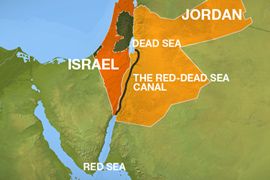The Red/Dead 'Peace' Canal

Red Sea canal plan 'threat'
By Omar Khalifa
July 19, 2008
The water level of the Dead Sea is dropping by an average of 1 metre per year [AP]
The World Bank has finished a series of public hearings on a project that would see a canal linking the Red Sea to the depleted and polluted Dead Sea, which lies between the West Bank and Israel to the west, and Jordan to the east.
But the Bank has been accused of presenting the canal as the "only option on the table" by environmental groups and geologists, who say the plan could in fact damage three local ecosystems, including the Dead Sea itself.
Perceived as a "peace conduit" at the behest of the Palestinian Authority, Israeli and Jordanian governments, opponents to the project say the political nature of the solution has meant arguments about saving the environment have fallen by the wayside.
The water level of the Dead Sea is dropping by an average of 1 metre per year. As a result, the great salt lake's continuing fall has threatened to affect the unique ecology and the economic development in the Dead Sea region.
Clive Lipchin, director of research at the Arava institute for environmental studies in Israel, said: "The Dead Sea is a unique ecosystem, the lowest point on earth and the only place where you can literally walk on water.

The proposed Red-Dead canal route
"It is important economically for tourism and agriculture for Israel and Jordan and it will be important for the economic development of a future Palestinian state."
The World Bank says the US$5 billion construction of a water conveyance system bringing salt water from the Red Sea to the Dead Sea would stabilise the water level of the Dead Sea and thus preserve tourism, agriculture and mineral extraction in the region.
But, according to many geologists and local scientists, the project concept poses a threat to three unique ecosystems; the Gulf of Aqaba/Eilat, the Arava Valley and the Dead Sea itself.
"The project calls for the largest seawater pumping plant in the world at the Gulf of Aqaba," Lipchin said. "The Gulf is already overdeveloped with 70 per cent coral mortality on the Israeli side.
"For the Arava Valley ... the threat is due to possible earthquakes and a break in the canal which will flood the valley with seawater destroying agriculture and polluting the groundwater used by Israel and Jordan.
"The most serious problem, where very little is known, is the mixing of the waters - the Dead Sea with the Red Sea.
"This is what is unique to the project and has never before been attempted. We simply cannot predict what the outcome will be," he said.
No alternatives
Gidon Bromberg, Israeli director of Friends of the Earth Middle East (FoEME), said: "The Bank is simply refusing to listen to real alternatives that have been put on the table."
Alexander McPhail, the World Bank's water and sanitation specialist tasked with leading the assessment, said that the Bank's study does include "an examination of a series of alternatives".
But Bromberg said consultants working with the World Bank have "no task allocated to study alternatives to the canal, other than a 'no action' alternative."
One "natural alternative" proposed by environmentalists and local geologists includes bringing water back to the Jordan River.
Over the past 50 years, the amount of freshwater carried into the Dead sea by the Jordan River has fallen from 1.3 billion cubic metres annually, to just 70 – 100 million cubic metres.
This is because Israel, Jordan and Syria now divert 95 per cent of the flow upstream.
"By diverting fresh water from the Jordan River tributaries and replacing it with sewage, not only has the Dead Sea been devastated but also the culturally and historically important Jordan River has been turned into little more than an open sewage channel," FoEME said.
As a result, environmental organisations are calling for the World Bank, Israel, Jordan and the Palestinian Authority to assess a project that would rehabilitate the Jordan River - a committment made by Jordan and Israel in the 1994 peace treaty. So far, no action has been taken.

The Dead Sea's buoyancy is incredibly high [AP]
Dan Zaslavski, a former Israeli water commissioner, estimated that regenerating the flow of the Jordan River to bring water to the Dead Sea will cost no more than US$800 million, substantially less than the US$5 billion it is estimated that will be required to complete the Red-Dead sea project.
However, the Bank has said that "no degree of reform and change in management of freshwater resources in the region is likely to keep pace with the demand, attain even the minimum standard of water availability or significantly contribute to the restoration of the Dead Sea."
A study that negates looking into the root cause of the problem, FoEME said, "puts the credibility of the World Bank into question".
Unheard and ill-informed
The Bank recently held three public hearings on the proposed Red-Dead canal project in Amman, Ramallah and Jerusalem, to engage people in the consultation process.
McPhail said: "Over 60 persons participated in the first meeting ... which is a good turn out for this type of meeting in World Bank experience."
Jordan and the Palestinian Authority "advertised these meetings in newspapers in advance and they were announced on a dedicated website," he said.
But Bromberg said: "In all three countries the advertisement was made one day prior to the public hearing.
"The public in fact received zero notice," he said.
Worse still, "failure to translate important documents to Arabic and Hebrew has meant that local communities remain ill-informed," the FoEME said.
While McPhail acknowledged that the canal was an "opportunity for expanded regional cooperation", the Bank has stated that the Red-Dead canal project is a primarily environmental one.
Earlier this year, Shimon Peres, the Israeli president, said the "project of the canal, or the peace conduit ... is vital for the preservation of the Dead Sea, but just as much for peace and prosperity in the area. In the Middle East we have used too much diplomacy and strategy, and too little economy."
For many geologists and environmentalists, the problem is that the Red-Dead canal project includes 'too little environment'.
The World Bank's feasibility study is expected to begin in September.
Note:
Jordan Times
Friday, March 20, 2009
Red-Dead Canal feasibility studies to conclude ahead of schedule
By Hana Namrouqa
AMMAN - The Red-Dead Canal Project’s environmental assessment and feasibility study will conclude six months ahead of schedule, a government official said on Thursday.
“We have cut the time frame by six months, thus the economic and environmental studies, which began last May, will be finalised in August or September next year,” Jordan Valley Authority Secretary General Musa Jamaani told The Jordan Times yesterday.
The decision, which reduced the total time for the studies to two years, was taken during a meeting earlier this month in Ein Jedi on the Israeli side of the Dead Sea between the project’s partners, he said.
“During the meeting, we reduced the studies’ time frame and cancelled some procedures that would have resulted in duplication,” explained Jamaani, who heads the project's steering committee on the Jordanian side.
The two studies are estimated to cost $15 million, with French company Coyne et Bellier carrying out the feasibility study, and British firm Environmental Resources Management conducting the environmental assessment.
The two companies provide monthly progress reports to the project's steering committee, which includes representatives from the World Bank and the project's three parties (Jordan, Palestine and Israel).
The Red-Dead Canal Project is part of international efforts to save the Dead Sea, which has been shrinking at the rate of one metre per year, largely due to the diversion of water from the Jordan River for agricultural and industrial use.
During the past 20 years alone, it has plunged more than 30 metres, with experts warning that it could dry up within the next 50 years.
Due to the water level drop, the sea's surface area has shrunk by at least 33 per cent over the last 56 years with an average annual inflow decrease from 1,200 million cubic metres (mcm) to around 250mcm of water.
The project, which will alleviate pressure on renewable and nonrenewable water resources in the region by providing about 850mcm of potable water annually, entails the construction of a 200-kilometre canal from Aqaba on the Red Sea to the Dead Sea.
The environment-focused project seeks to pump one billion cubic metres of water annually with the aim of raising water levels in the shrinking lake from 408 metres below sea level to 315 metres.
